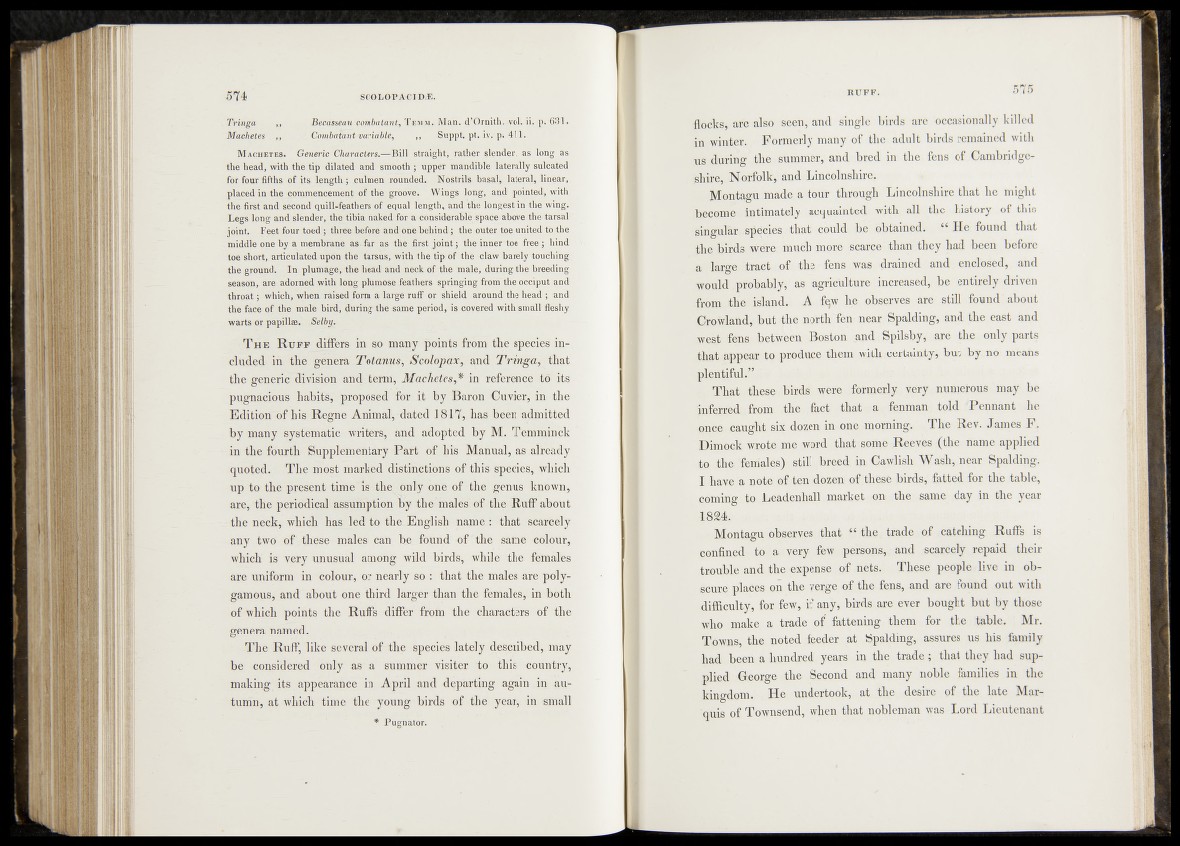
Tringa „ Becasseau pojnbatant, Tem ar. Man. d’Ornith./V.pl,. ii. p. 631.
Machetes ,, Combatant-variable, „ Snppt. pt.jjSpp. 4L1..
M achetes. Generic Characters.—Bill straight, rather slender, as long as
the head, with the tip dilated and smooth ; upper mandible laterally sulcated
for four fifths of its length; .cujmen rounded, .l^ostrils basal, lateral, linear,
placed in the commencement of the groove. Wings long, and pointed; with
the first and second quill-feathers of equal length, and the longest in the wing.'
Legs long and slender, the tibia naked for a considerable ‘space above th'e- tarsal'
• joint. Feet four toed'; three before and one behind; the outer toe united to the
middle one by a membrane as far as the first joint; fhednner*toe free ; hind
toe short, articulated upon the tarsus, with the tip of the claw barely touching,
the ground. In plumage, the head and neck of the male, during the breeding,
season, are adorned with long plumose feathers springing from"the occiput and
throat; which, when raised form a large ruff or shield around the head'; and
the face of the male bird, during thé same period, is covered wjth small ‘fl'éshy
warts or papillae, Selby,.
T h e R uff differs in so many points from the .specifeS included
in the genera Totanus, Scolopax, and Trmga,f$Èat
the generic division and , term, Machetes,* in referèficèftff its
pugnacious habits, proposed f»r*it Baron in the
Edition of his Regne Animal, dated 1817, has been ^admitted
by many systematic writers, and adopted by M. Tejninim k
in the fourth Supplementary Part of his Manual,' as aSeMy
quoted. The most marked distinctions of this species, which
up to the present timers the only one of the genus knbwn,
are, the periodical assumption by the males. of the Ruff about
the neck, which has led to -the „English namel' -that scarcely
any two of\fhese--males can be found o f' the sameppffeiar,
which' is very unusual among wild hijtds, while the females
are uniform in colour, or nearly so : that the-males are polygamous,
and about one third larger than the females, in both
of which points the Ruffs differ from the characters of the
genera named.
The Ruff, like several of the species lately described, may
be considered only as a summer visiter ’to this country,
making its appearance in April and departing again in autumn,
at which titne the young birds of the year, in small
* Pugnator.
flocks, are also seen, and single birds are occasionally killed
in winter. Formerly many of the adult birds remained with
us during the summer, and bred in the fens of Cambridgeshire,
Norfolk, and Lincolnshire,
Montagu made a tour through Lincolnshire that he might
become intimately acquainted with all the history of this
singularus^ëcies that- could* be obtained. “ He found that
the birds were much more scarce than they had been before
a large tract .of^t'he - fens v was drained and enclosed, and
would .probably^ as agriculture increased, be entirely driven
from-thbt.island. A fqw he, observes are still found about
Crowland, but -the nprthTfen near Spalding, and the east and
,wes£ ,fens between sRoston and Spilsby, are the, only parts
that appear to produce them with certainty, but by. no means
plentiful.” ’
Thati#hese , birds were formerly very numerous may be
inferred, from the fact that a fenman told 'Pennant he
pnce caught six dozen in one morning.. The Rev. James F,
Dimbok. w>tejme word that;some Reeves (the name applied
to the f f e m a l ^ s P , breed, in Cawlish Wash, near Spalding,
I haVte-a note- of ten dozen of thesp birds, fatted for the table,
c om in gL e a d e n h a ll market on same day in the year
1824,;
Montagu observes.,that “ trade of catching Ruffs, if
confined tp^a very few persons,; and scarcely repaid their
trouble and the, expense of néts. These, people live in obscure
places om the.verge, of the fens, and are found out with
difficulty, for few, if any, birds are ever bought but by those
who makei.a trade of fattening them for the table. Mr.
Toms, the noted feeder at Spalding, assures us his family
had been a hundred years iu the trade; that they had supplied
Creorge the Second and many noble families in the
kina-dom. He undertook, at the desire of.the late Mar- ■ O '
'quis of Townsend, when that nobleman was Lord Lieutenant